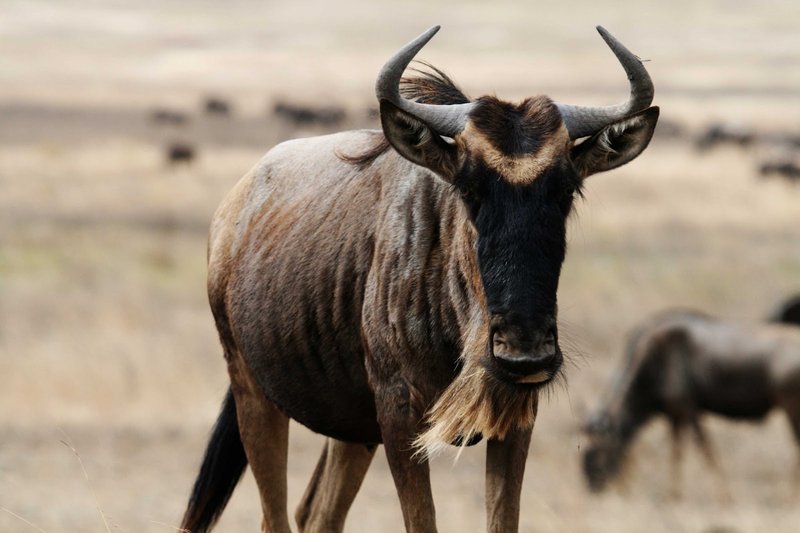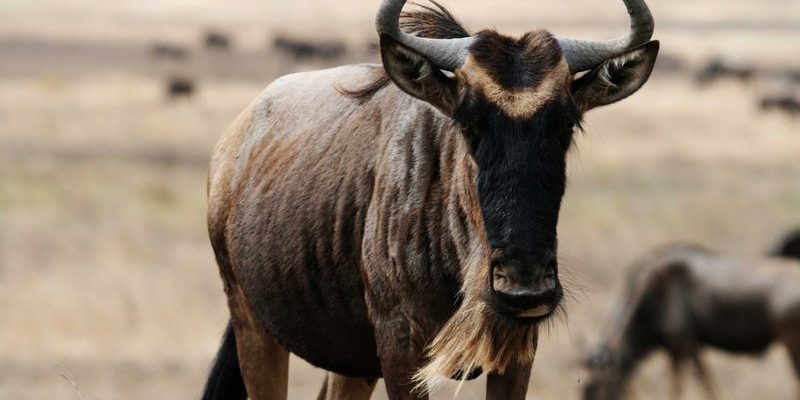
Wildebeests, also known as gnus, are often best known for their epic migrations, which can draw gasps from anyone lucky enough to witness them. These migrations are not just for show; they are central to the wildebeest’s life cycle and survival. So, grab your coffee, and let’s dive into the wild world of these amazing creatures. Here are ten intriguing facts about the wildebeest that you might not know.
1. The Great Migration
One of the most awe-inspiring events in nature is the **Great Migration**, where millions of wildebeests, along with zebras and other herbivores, move across the plains of the Serengeti and Maasai Mara. This seasonal journey, stretching over 1,200 miles, is driven by the search for fresh grazing and watering holes. Imagine thousands of wildebeests marching together, their hooves thundering across the earth, creating a spectacle that echoes through the savannah.
The migration typically follows a cycle, starting in Tanzania as the wildebeests move northward towards Kenya. This trek isn’t just about travel; it’s about survival. The wildebeests instinctively know where to go based on the **seasonal rains** that refresh their habitat. When you see that many animals moving in unison, it feels almost like nature’s choreography, with the wildebeests perfectly in sync.
2. Unique Social Structure
Wildebeests are social animals that live in herds, often forming groups that can number in the thousands. Within these herds, there’s a **clear social hierarchy**. Adult males typically dominate, but females also play vital roles, especially when it comes to raising young calves. Each wildebeest has its own personality; some are more dominant, while others might be shy and reserved.
Interestingly, wildebeests communicate using a range of sounds, including grunts and snorts. So, next time you’re enjoying a documentary, pay attention to the “conversation” happening in the herd. It’s like a wild social network where every member has a role to play, keeping everyone safe from predators while ensuring the group stays together.
3. Adaptations for Survival
Wildebeests are equipped with several fantastic adaptations that help them thrive in their harsh habitats. For one, their large, muscular bodies are designed for endurance, making long-distance migrations a breeze. Their strong legs enable them to sprint away from predators, but here’s the thing: they often rely on their sheer numbers for protection.
When a predator, such as a lion, approaches, wildebeests will often form a protective circle around the calves, ready to defend. It’s a natural defense mechanism that’s been honed through generations. Their **keen eyesight** and knack for detecting danger help maintain the safety of the herd.
4. Grazing Habits
Wildebeests are primarily grazers, feeding on grasses throughout the day. Their diets mainly consist of short grasses, which they can munch down to the roots, creating a direct impact on the ecosystem. Grazing helps keep the grasslands healthy and promotes new growth, thus supporting other wildlife.
You might be wondering how they know where to graze. Wildebeests have excellent memories for locations with the best grazing spots. They can even remember locations where they’ve found water in the past, which is vital for their survival during the dry seasons. This memory makes them not only smart but also strategic in their movements.
5. Calving Season
One of the most extraordinary times in a wildebeest’s life is calving season, which occurs just after the migration when they reach greener pastures. During this period, about 500,000 calves are born within a few weeks! It’s an astonishing sight to see thousands of little calves taking their first steps while their mothers guard them fiercely.
The survival rate of calves is quite low due to predators, but the sheer number of births boosts the chances that some will thrive. The mothers are incredibly attentive, and their instinct to protect their young is impressive. You could say it’s nature’s way of ensuring the future of the species!
6. An Interesting Relationship with Zebras
Wildebeests and zebras share a unique relationship that benefits both species. While wildebeests primarily focus on grazing, zebras are more adept at spotting predators due to their excellent eyesight and awareness. This partnership allows them to cohabitate and create a safer environment for both.
When grazing, you might notice that they often feed together; the **zebras alert** the wildebeests to potential dangers while the wildebeests help to keep the grass short, making it easier for zebras to graze. It’s a classic example of symbiosis in nature, showcasing how cooperation can lead to survival.
7. Lifespan and Growth
Wildebeests can live around 20 years in the wild, although many factors can shorten their lives, like predators or disease. Since they grow quickly, calves can stand and walk shortly after birth, which is crucial for their survival in the wild.
By the time they reach 3 years old, they’re considered adults. During this time, they undergo several changes, including developing those impressive horns that can grow up to 80 centimeters long. These horns are not just for show; they play a crucial role in **establishing dominance** during mating season.
8. Predators and Threats
Like many species, wildebeests face several threats in their natural habitat. Predators like lions, hyenas, and crocodiles hunt wildebeests, especially during the migration. The sheer size of the herds often helps in deterring these hunters, but every wildebeest is still at risk.
Poaching and habitat loss due to human encroachment are significant challenges for wildebeests as well. It’s disheartening to see how human activity can impact wildlife, but conservation efforts are underway to protect these magnificent animals and their ecosystems.
9. Cultural Significance
In many African cultures, wildebeests hold a significant place in the ecosystem. They are often seen as symbols of resilience and adaptability. Their migrations are also central to the traditions of many tribes in the region, representing the cycle of life and the importance of living in harmony with nature.
Documentaries and photography explore the grand migrations and shed light on the challenges these animals face, promoting awareness and appreciation for wildlife. The wisdom of observing how they coexist and migrate can inspire us to find balance in our lives too.
10. Conservation Efforts
With habitat loss and poaching threatening their existence, conservation efforts are crucial. Various organizations are working hard to preserve wildebeests and their natural environment. These efforts involve creating protected areas, working with local communities, and promoting ecotourism to generate support for wildlife preservation.
By raising awareness and encouraging responsible tourism, we can help ensure that future generations get to witness these magnificent creatures in their natural habitat. Every effort counts when it comes to preserving the delicate balance of our ecosystems.
In conclusion, wildebeests are not only fascinating creatures but also essential components of their ecosystems. Their migrations, social structures, and adaptations reveal the beauty of nature and the importance of conservation. Understanding and appreciating these animals can inspire us to take better care of our shared planet. Whether you’re watching a documentary or reading this article, let’s celebrate the wildebeest and all the wonders they bring to our world.

